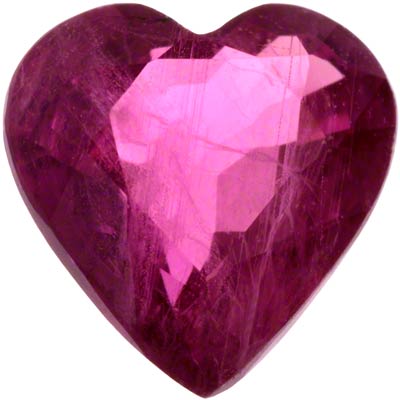| The Very Highest Quality Gemstone Information... |
| Ruby |

|
|
|
| < |
Corundum
Corundum is the mineralogical name for aluminium oxide.
Colours
Corundum can be colourless, red, pink, red, black, brown, orange, yellow, green, indigo, violet, or mauve. Red corundum and most pink corundum is called ruby, all other colours are called sapphire, usually with the colour specified as a prefix to the word ruby, for example, yellow sapphire.
Colouration
Pure corundum is colourless, often called white, and although quite rare, tends not to be valuable because it does not have much brilliance. Colours, as in many gemstones, are caused by small amounts of impurity, usually metallic oxides. This is a case where impurity is desirable.
Chromic oxide causes brilliant red colouring in corundum, thereby producing rubies.
Ferric oxide causes yellow colouration, titanium oxide produces vivid red.
In fact the colouration of ruby is not quite so simple as this. The titanium and iron are usually present in the form of ilmenite, a mineral which is a titanium iron oxide, TiFeO3. Ilmenite is not isomorphous with aluminium oxide. Isomorphous means being able to replace the host mineral within its crystal structure. Instead ilmenite is present as a microscopic inclusion, in the form of colloidal particles.
This colloidal nature may be responsible for other optical effects such as "silk", asterism, and colour banding.
Hardness
Corundum is very hard, having a hardness of 9 on Moh's scale, compared with 10 for diamond, and 8 for topaz. Hardness is generally a desirable feature is gemstones.
Other uses for corundum, because of its hardness, are as watch bearings, watch glasses, and as an abrasive.
Sources
Originally, the best sapphires and rubies came from Burma, where they are believed to have been mined possibly from prehistoric times. Certainly they appear to have been worked during the times of Marco Polo.
Thailand, previously called Siam, is an important source of attractive ruby. Thai rubies are usually pink rather than red, and often slightly pale and silky.
Prices
The price range of rubies is very large, ranging from under £1 per carat to many thousands of pounds per carat, depending primarily on colour, but also on brilliance, which is affected by clarity and cutting.
Large, brilliant rubies are very rare and expensive.
The Best and Most Valuable Colour
Many people seem to believe that the darker the ruby the better. just as many seem to believe the opposite. Neither of these opinions is correct. If you think, even briefly, about this it becomes obvious why. A very dark ruby would appear black, and would not be very attractive or desirable. The darkness often being caused by inclusions. An extremely pale ruby would be colourless, and not particularly attractive or valuable.
As usual, the truth lies between the two extremes. The most desirable rubies are generally those with an intense red colour, and plenty of sparkle and life. These latter two factors are usually helped by high optical clarity and skilful cutting.
Ultimately which is "best" is a subjective matter, and personal preference is important. Our usual advice to potential customers is to buy whichever colour of ruby they personally find the most attractive. We also think it's slightly sad that we need to give this advice. Buy what you like, using your own judgment, rather than allowing yourself to be a slave to fashion and buying what you think will impress other people.
The main choice in the colour of rubies depends largely whether you prefer red or pink.
One important factor when selecting a ruby is to ensure that it will not clash with your nail varnish or other clothing and accessories. This is a more important factor with ruby than with almost any other gemstone. Colourless diamonds, blue sapphires, and green emeralds hardly ever clash with other colours, whereas reds and pinks require considerable more care when mixing with similar colours.
Cleaning
Ruby jewellery can be cleaned using hot soapy water, or detergent, rinse thoroughly afterwards as detergents can cause dermatitis and allergic reactions. Enzyme cleaners should be avoided for the same reasons. Brushing with an old tooth brush to remove dirt and grease will also help. Cleaning agents containing chlorine may have a detrimental effect on low carat gold alloys, so are best avoided.
Technical Data
| Chemical Composition and Name | Al2O3 - Aluminium Oxide |
| Hardness | 9 |
| Refractive Index | 1.759 - 1.767 to 1.770 - 1.779 |
| Specific Gravity | 3.96 - 4.01 |
| Birefringence | 0.009 |
| Crystalline System | Trigonal |
Rubies for Sale
A selection of loose, unmounted, rubies for sale.
| ...at the Lowest Possible Price |
|
32 - 36 Harrowside, Blackpool, Lancashire, FY4 1RJ, England. Telephone (44) - (0) 1253 - 343081 ; Fax 408058; E-mail: The URL for our main page is: https://24carat.co.uk | Chard(1964) Ltd |